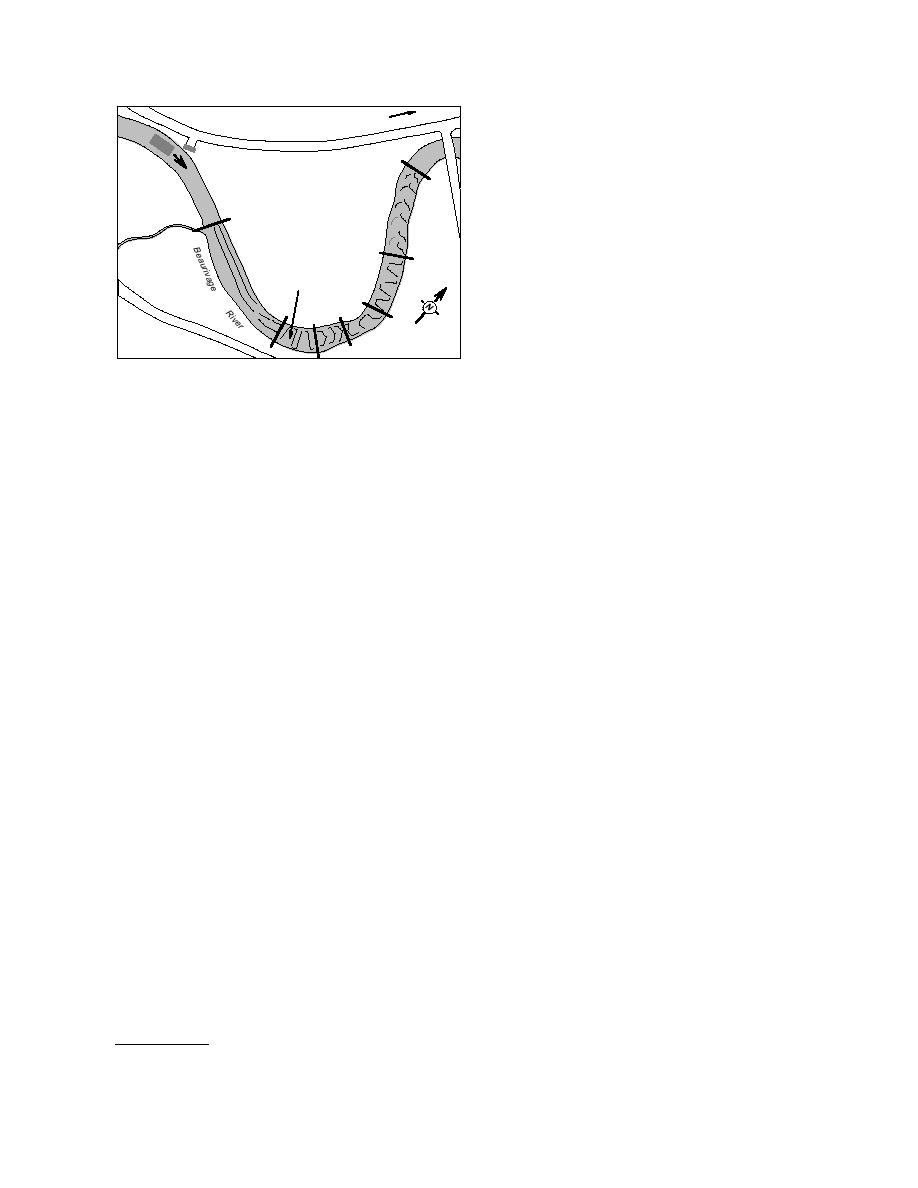
enough in the season such that water in the
ity
Quebec C
trenches could freeze and defeat the operation.
Flo
w
On the other hand, if warm sunny weather was
anticipated, the slots could be cut completely
through the ice since the low albedo of water in
the trenches could absorb additional solar radia-
tion, leading to accelerated ice decay.
St. Etienne
Village
Ice deterioration
Ice deterioration occurs both through thermal
Location of
Ice Jam Priming
melting and through decay of its internal struc-
ture. With higher air temperatures, higher sun
angles and longer days in the spring, the winter
snow cover and the top surface of the ice begin to
melt, forming a water layer. With the reflective
Figure 8. Map of Beaurivage River ice cutting. (After
snow cover gone, this water layer absorbs more
Jolicoeur et al. 1984.)
solar radiation, and deterioration of the ice struc-
ture along crystal boundaries can take place. The
an evaluation of their performance in a river-
ice becomes progressively thinner and weaker,
bend. A general map of the area along with a
and given time the ice will melt in place.
depiction of the cutting patterns is shown in Fig-
One technique that has been used to accelerate
ure 8.
the decay of an ice cover is dusting. The term dust
The patterns were cut in the ice using an un-
is used here to denote any dark material that can
modified Case DH4 trencher. This trencher has a
be spread on the ice in a thin layer so as to absorb
chain width of 15 cm and an in-line trenching
solar radiation and thereby accelerate the deterio-
speed of about 8 m/min (26 ft/min). Trenching a
ration process. Dusting has been used in the
600-m (2000-ft) bend using the five patterns took
Omaha District to reduce ice-related flooding po-
eight hours, or a normal working day. Although
tential on the Platte River in Nebraska (USACE
all cutting patterns worked well, the authors felt
1979). Moor and Watson (1971) described the use
that the most efficient pattern was the one con-
of dusting on the Yukon River in Alaska. They
sisting of an unconnected "V" pattern shown far-
found that dusting a river reach subject to peren-
thest downstream in Figure 8.
nial jamming two to three weeks prior to breakup
Jolicoeur et al. (1984) concluded that trenching
weakened the ice sufficiently so that no jams
breaks more ice than blasting, costs about a third
formed there during years when dusting was
as much, has no adverse environmental effects
performed. Ideally the dust should be applied as
and is far safer. Ice trenching has been used as an
early as possible to provide maximum deteriora-
advance measure on the Beaurivage River annu-
tion time but after the last snowfall (which would
ally since 1984.* Because significant ice strength is
cover the dust and render it useless).
required to support the large trenching machine
Dusting materials can include such substances
initially employed, ice cutting on the Beaurivage
as fly ash from the burning of coal or pit run sand.
River since 1986 has been conducted with a spe-
Moor and Watson (1971) suggested an applica-
cially designed "Aquaglace" ice trencher that
tion rate of 0.5 lb/yd2 for sand and 0.35 lb/yd2 for
was lighter and safer to operate on thin or weak
fly ash. Sinotin (1973) cited values of 0.18 lb/yd2
ice (Belore et al. 1990).
for 0.04-in. material and 0.92 lb/yd2 for 0.2-in.
Each of these reports has discussed ice cutting
material. Problems with aerial dusting identified
that involved completely cutting through the ice,
by Moor and Watson (1971) include moisture (the
allowing the cut slot to fill with water. With the
material must be dry enough to flow freely and
smooth, uniform ice sheet present in the Buford
not freeze), wind (even a slight breeze can cause
Trenton area, however, it would be possible to cut
drifting of fine materials and require low release
a trench that doesn't quite penetrate the cover, al-
altitudes) and ice or glazed snow surface (the
lowing the slot to remain dry. This would be an
dust can drift after landing). The potential for ad-
advantage if cutting were conducted early
verse environmental impacts of the dusting mate-
rial must also be considered.
* Personal communication, B. Michel, Universite de Laval,
Instead of aerial dusting, it is also possible to
Quebec City, Canada.
18



 Previous Page
Previous Page
